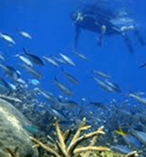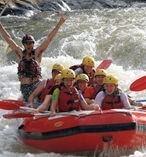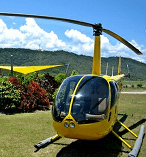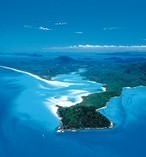GREAT BARRIER REEF, AUSTRALIA
Reason to visit
The Great Barrier Reef is one of the seven natural wonders of the world, home to an incredible diversity of sea life. It's the largest coral reef in the world, covering more than 345,000 square kilometers. But lately, the reef is losing more and more of its living outer layer. That's according torecent research in Proceedings of the National Academy of Sciences. Looking back to 1985, scientists found that thenumber of living polyps has declined from more than 25 percent of the reef's surface to just under 14 percent. Most of that loss has come in the last decade or so in areas where humans live closest to the reef.
The problem is the number of challenges facing the reef. There's coral bleaching due to the hot temperatures induced by human-caused climate change. There's our sewage and agricultural runoff flowing into the sea. There are even outbreaks of coral-chomping starfish, aided and abetted by human activity. Not all is lost. The relatively pristine northern end of the reef shows that coral could recover, given the chance. For that to happen, we all will have to do more to combat climate change.
Location
The Great Barrier Reef is the world's largest coral reef system composed of over 2,900 individual reefs and 900 islands stretching for over 2,600 kilometers (1,600 mi) over an area of approximately 344,400 square kilometers (133,000 sq mi). The reef is located in the Coral Sea, off the coast of Queensland, Australia.
The Great Barrier Reef can be seen from outer space and is the world's biggest single structure made by living organisms. This reef structure is composed of and built by billions of tiny organisms, known as coral polyps. It supports a wide diversity of life and was selected as a World Heritage Site in 1981. CNN labeled it one of the seven natural wonders of the world.[8] The Queensland National Trust named it a state icon of Queensland.
A large part of the reef is protected by the Great Barrier Reef Marine Park, which helps to limit the impact of human use, such as fishing and tourism. Other environmental pressures on the reef and its ecosystem include runoff, climate change accompanied by mass coral bleaching, and cyclic population outbreaks of the crown-of-thorns starfish. According to a study published in October 2012 by the Proceedings of the National Academy of Sciences, the reef has lost more than half its coral cover since 1985.
The Great Barrier Reef has long been known to and used by the Aboriginal Australian and Torres Strait Islander peoples, and is an important part of local groups' cultures and spirituality. The reef is a very popular destination for tourists, especially in the Whitsunday Islands and Cairns regions. Tourism is an important economic activity for the region, generating over $3 billion per year.
Ways to get there
AIRPORT
There are no direct flights to the Great Barrier Reef, but Virgin Blue (www.virginblue.com.au) and Jetstar (www.jetstar.com.au) do fly from Brisbane, Cairns, Sydney & Melbourne to Hamilton Island and Proserpine (Whitsunday Coast). For flights from London, either go to Cairns or Brisbane, and from there you can travel by water taxi or seaplane to your island destination.
AIRLINES FROM THE UK
(0844 493 0787; www.britishairways.com) flies from London, via Brisbane, to Cairns; Qantas (020 8600 4300; www.quantas.co.uk) flies directly to Cairns; and Garuda Airlines (www.garuda-indonesia.com) offer seas return ticket to Cairns, via Bali.
Austravel (www.austravel.com) offers tailor-made package holidays to most islands, including Heron, Lizard, Dunk and the Whitsunday Islands. Tailor Made Travel (www.tailor-made.co.uk) has an 'Australia Naturally' brochure, which features personalised packages to the Great Barrier Reef and all around Australia.
In general, visiting the Great Barrier Reef is far from cheap, but most resorts do have cut-rate deals. Resort reservations made through local airlines or Qantas can produce savings, particularly in the cost of round-trip transfers, which are often not included in the resort rate and vary wildly. For last-minute travellers, standby packages are often available; travel agencies in Arlie Beach specialise in these: try Whitsunday Travel Centre (www.whitsundaytravel.com.au). When making reservations directly with a resort, ask about special deals and discounted rates.
Things to do
Great Barrier Reef Snorkeling Cruise
 The beauty of the Great Barrier Reef is apparent as soon as you set your eyes upon it; however, put your head under the crystal-clear water and you'll be immediately exposed to the astounding array of beautiful life forms that dwell just under its surface.
The beauty of the Great Barrier Reef is apparent as soon as you set your eyes upon it; however, put your head under the crystal-clear water and you'll be immediately exposed to the astounding array of beautiful life forms that dwell just under its surface.
A snorkeling trip will allow you to escape into this new world full of surprises, and a cruise that will take you to the magnificent Outer Reef to a spacious activity platform permanently moored at a wonderful site will serve as the ideal springboard for guests of all ages – swimmers and non-swimmers alike – to enjoy a day of discovery. You can snorkel directly from the platform and instantly find yourself among stunning coral gardens and colorful marine life – or you can take part in the Eco talks, reef presentations, board an air-conditioned semi-submersible for views without getting wet, and enjoy morning and afternoon teas along with a delicious gourmet lunch.
Outer Reef Snorkeling Cruise
 Port Douglas provides another natural departure point to experience the joys of the Great Barrier Reef, and the Outer Reef in particular is in its own class; brimming with vibrant coral gardens and diverse marine life, it makes for one of the best snorkeling destinations in the entire world.
Port Douglas provides another natural departure point to experience the joys of the Great Barrier Reef, and the Outer Reef in particular is in its own class; brimming with vibrant coral gardens and diverse marine life, it makes for one of the best snorkeling destinations in the entire world.
This cruise will take you aboard a speedy, wave-piercing catamaran all while in air conditioned comfort to the highly regarded Agincourt Reef – a jewel-like ribbon reef on the very outer edge of the Great Barrier Reef proper that showcases a series of unsurpassed coral formations, colorful marine creatures and an outstanding level of underwater visibility. A spacious activity platform awaits that allows you to participate in a huge range of reef activities including snorkeling and diving, semi-submersible viewing, fish feeding presentations and much more.
Green Island Day Trip
 Green Island is a stunningly beautiful coral cay that lies approximately 45 minutes off the coast of Cairns via catamaran that has existed for around 6000 years, and today acts as home to over 120 native species of plants and colorful bird life – a true nature lover's paradise in the heart of the Great Barrier Reef. A true paradise for nature-lovers, this day trip to Green Island includes snorkeling as well as an informative glass bottom boat tour that will allow you to fully explore this lovely island destination.
Green Island is a stunningly beautiful coral cay that lies approximately 45 minutes off the coast of Cairns via catamaran that has existed for around 6000 years, and today acts as home to over 120 native species of plants and colorful bird life – a true nature lover's paradise in the heart of the Great Barrier Reef. A true paradise for nature-lovers, this day trip to Green Island includes snorkeling as well as an informative glass bottom boat tour that will allow you to fully explore this lovely island destination.
Many additional inclusions are provided within the package, such as the use of the island's great swimming pool and an Eco island walk to discover some of Green Island's distinctive rain forest flora. A range of restaurant and cafe-style lunch options along with additional activities including scuba and helmet diving, para sailing and scenic helicopter flights are also available upon request, making the day as involved or laid back as you choose.
Hot Air Ballooning
 The great heights that hot air ballooning will send you to will provide amazing views not only of the Great Barrier Reef itself but also the incredible natural surroundings that make up the geography of this tropical north Queensland region.
The great heights that hot air ballooning will send you to will provide amazing views not only of the Great Barrier Reef itself but also the incredible natural surroundings that make up the geography of this tropical north Queensland region.
Ascend into the skies above Cairns and experience the sheer wonder, romance and silent serenity of the far north QLD bush land, golden sand beaches and stunning azure waters. After you've experienced the reef and the rain forest up close, a hot air balloon ride is the next best thing to do at the Great Barrier Reef – a breathtaking experience that cannot be missed!
Whitewater Rafting
 Pristine rain forest, crystal-clear rivers and breathtaking scenery are just a few of the reasons to take a whitewater rafting trip on the beautiful Russell and Barron Rivers, located just a short distance inland from the Great Barrier Reef. As some of the most popular rafting destinations in the world, these two great waterways offer unequaled chances for an affordable, exciting and exhilarating day out.
Pristine rain forest, crystal-clear rivers and breathtaking scenery are just a few of the reasons to take a whitewater rafting trip on the beautiful Russell and Barron Rivers, located just a short distance inland from the Great Barrier Reef. As some of the most popular rafting destinations in the world, these two great waterways offer unequaled chances for an affordable, exciting and exhilarating day out.
A series of different rapid courses ranging from grades one to four ensure that there is something available for people of all experience and skill levels, and most packages also include a relaxing picnic lunch. All rafting trips are guided by skilled guides who will show you the best ways to negotiate the rapids while maintaning a premium on safety so that you can simply enjoy the feeling of excitement without ever feeling a true sense of danger. Whether travelling as an individual, couple, or group, whitewater rafting near the Great Barrier Reef is an experience that will serve to make you feel more alive!
Low Isles Sailing Cruise
 Set sail for the Low Isles of the great barrier reef – a true tropical island paradise – that combines ideally with the inherent romance of sailing aboard a luxurious 30m sailing catamaran on this Low Isles Sailing Cruise. One of the true jewels of the Great Barrier Reef, the Low Isles are an idyllic series of unspoiled islands that provide a perfect microcosm of what the Reef and its surrounds are all about.
Set sail for the Low Isles of the great barrier reef – a true tropical island paradise – that combines ideally with the inherent romance of sailing aboard a luxurious 30m sailing catamaran on this Low Isles Sailing Cruise. One of the true jewels of the Great Barrier Reef, the Low Isles are an idyllic series of unspoiled islands that provide a perfect microcosm of what the Reef and its surrounds are all about.
Mooring in a calm, picturesque lagoon, a huge range of reef activities await to be participated in including glass-bottom boat rides to view the wide array of marine life, snorkeling over the colorful coral gardens filled with turtles and brilliantly vibrant fish, guided beach walks, or simply relaxing on the beach or on the decks of the boat while soaking in some sunshine – taking time in the middle of the day to enjoy a delicious tropical buffet lunch.
Great Barrier Reef Scenic Helicopter Flight
 Flying from Port Douglas aboard a helicopter and heading out over the reef is one of the best ways to gaze down through the surface of its pristine, transparent waters to witness the coral and other marine life from directly above. Helicopter rides offer a vantage point of the Reef rarely seen by most people, as hovering at low altitudes allows you to witness the wonders that leave beneath from close up.
Flying from Port Douglas aboard a helicopter and heading out over the reef is one of the best ways to gaze down through the surface of its pristine, transparent waters to witness the coral and other marine life from directly above. Helicopter rides offer a vantage point of the Reef rarely seen by most people, as hovering at low altitudes allows you to witness the wonders that leave beneath from close up.
Once we reach your destination we'll land for a hot and cold tropical buffet lunch and give you the chance for a snorkeling adventure, underwater observatory, or semi-submersible viewing session to witness the reef from an under-the-surface perspective.
Explore the Daintree Rain forest
 The amazing blues of the ocean that blankets the Great Barrier Reef is not the only visually incredible display on offer in the region; look inland and you'll soon come across the vibrant greens of some of the oldest and most beautiful rain forest in the world – the ancient and World Heritage-listed Daintree Rain forest. Regardless of whether you choose to divide the day between the reef and the rain forest or spend your time exploring this wondrous green ecological playground, the Daintree will doubtlessly leave an impression on you that will last a long time.
The amazing blues of the ocean that blankets the Great Barrier Reef is not the only visually incredible display on offer in the region; look inland and you'll soon come across the vibrant greens of some of the oldest and most beautiful rain forest in the world – the ancient and World Heritage-listed Daintree Rain forest. Regardless of whether you choose to divide the day between the reef and the rain forest or spend your time exploring this wondrous green ecological playground, the Daintree will doubtlessly leave an impression on you that will last a long time.
Brimming with wonderful wildlife and lush surroundings that make this area of far north QLD one of the most popular holiday destinations in the world, you'll find some of the last vestiges of the most ancient rain forest where a combination of primitive animals, plants and an indigenous culture still thrive to this day.
Take a Seaplane Flight over the Whitsundays
 Bordered by the Great Barrier Reef on one side and 74 tropical islands that lie in the calm waters of tropical north QLD's Coral Sea, the Whitsunday Islands lie midway along Queensland's coast. A huge number of spectacular destinations can be found within this island chain, including Heart Reef, Hardy Lagoon and White-haven Beach, and there are few better ways to gain an appreciation for their beauty than by a scenic seaplane flight that will take you directly above these natural marvels.
Bordered by the Great Barrier Reef on one side and 74 tropical islands that lie in the calm waters of tropical north QLD's Coral Sea, the Whitsunday Islands lie midway along Queensland's coast. A huge number of spectacular destinations can be found within this island chain, including Heart Reef, Hardy Lagoon and White-haven Beach, and there are few better ways to gain an appreciation for their beauty than by a scenic seaplane flight that will take you directly above these natural marvels.
Travelling at varying altitudes and the ability to fly close to the ocean's surface means you'll be able to soak in the incredible colors and textures of the Whitsundays and the Barrier Reef in the span of half a day, with numerous different options available that each emphasize a different aspect of this stunningly beautiful Australian archipelago.
 Recently dubbed The Best Beach in Australia, White-haven Beach is an emblem that embodies what everyone's image of the Great Barrier Reef is all about. With its pristine white silica sand clashing beautifully with the surrounding vibrant blue waters, it's not hard to see why White-haven is such a highly regarded travel destination. Be sure to take some time to simply absorb the beach - it's the perfect excuse for some down time among the cavalcade of water sports and other activities you'll no doubt be otherwise occupying yourself with - by picking up a handful of the finely-grained sand and feeling it run through your fingers.
Recently dubbed The Best Beach in Australia, White-haven Beach is an emblem that embodies what everyone's image of the Great Barrier Reef is all about. With its pristine white silica sand clashing beautifully with the surrounding vibrant blue waters, it's not hard to see why White-haven is such a highly regarded travel destination. Be sure to take some time to simply absorb the beach - it's the perfect excuse for some down time among the cavalcade of water sports and other activities you'll no doubt be otherwise occupying yourself with - by picking up a handful of the finely-grained sand and feeling it run through your fingers.
Various tours are available that will take you to White-haven Beach and offer different itineraries, and the majority offer a comprehensive look at all aspects of not just the beach but its surrounding islands and diving/snorkeling spots as well. Stretching out over a fairly substantial expanse of around seven kilometers in total, White-haven is not just some little pocket of beach that happens to be picture-perfect; it's a true, expansive beach that is large enough to ensure that even in peak seasons you'll likely still be able to garner a sense of solitude.
The beach is rarely overcrowded, and those visiting the Great Barrier Reef are advised to get their visit in quick as the beach's increasing worldwide fame and reputation may lead to its conditions beginning to deteriorate in the near future. You can book a full day cruise to White-haven by clicking the link below.


































